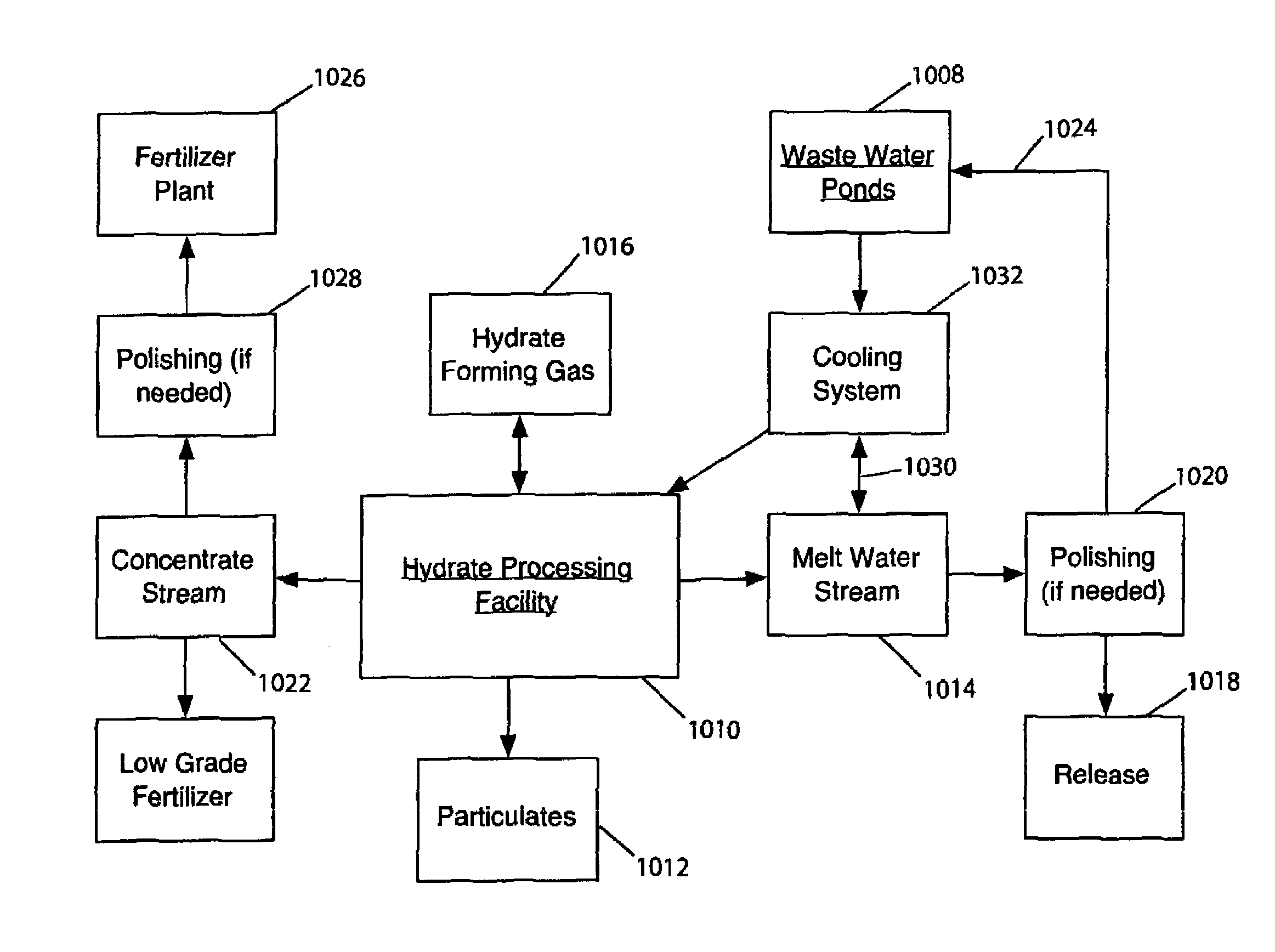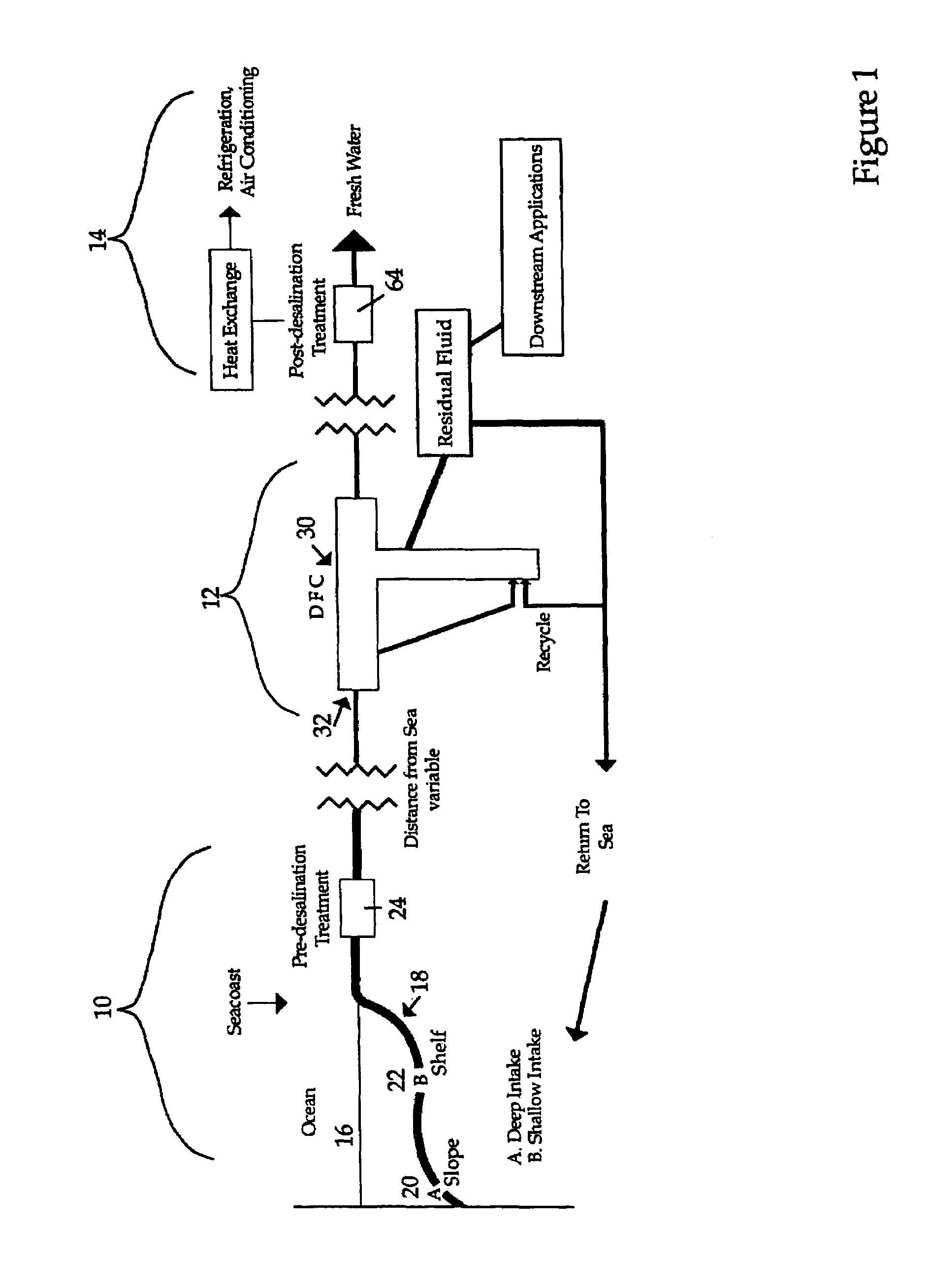Hydrate-based reduction of fluid inventories and concentration of aqueous and other water-containing products
a technology of aqueous and other water-containing products and inventories, which is applied in the direction of differential sedimentation, solid separation, and calcium/strontium/barium sulfates, etc., can solve the problems of significant biodegradation and environmental impact, easy to destroy most aquatic organisms, and large so as to reduce the volume of waste water and reduce the volume of industrial waste water. , the effect of reducing the volume of industrial waste water
- Summary
- Abstract
- Description
- Claims
- Application Information
AI Technical Summary
Benefits of technology
Problems solved by technology
Method used
Image
Examples
embodiment 230
[0077]The embodiment 230 is simplified in that heat of formation of the hydrate is transferred to water surrounding the thermal equilibration column 132 within a “water jacket” defined between the walls of the column 132 and the shaft 136 in which the desalination fractionation column is constructed. To this end, the hydrate formation conduit preferably is made from fabricated (i.e., “sewn”) artificial fiber material, which is ideal because of its light weight and its potential for being used in an open weave that greatly facilitates thermal equilibration between residual saline water within the thermal equilibration column 132 and seawater circulating within the water jacket.
[0078]As is the case with the embodiment shown in FIG. 2, warmed water is pumped out of the system, this warmed water being water which has circulated within the water jacket. In contrast to the embodiment shown in FIG. 2, however, the intent of removing warmed water from the water jacket is not to remove so mu...
embodiment 430
[0081]Whereas the embodiments described so far utilize gas or mixtures of gas which form positively buoyant hydrates under appropriate temperature and pressure conditions, the versatility of hydrate-based desalination, purification, or other fluid treatment can be expanded greatly by adapting the methods and apparatus described above to accommodate negatively buoyant hydrates. An embodiment 430 of a hydrate fractionation “column” configured to permit the use of negatively buoyant hydrate for water purification is shown in FIGS. 8-10. The major difference between this embodiment 430 and the preceding embodiments of hydrate fractionation columns is that the heat exchange and dissociation portion 350 of the installation is laterally or horizontally displaced or offset relative to the hydrate formation and heat removal sections 336 and 346, respectively. The hydrate formation and heat removal sections are similar to those in the embodiments described above.
[0082]A number of different op...
embodiment 600
[0114]An embodiment 600 in which dissociation and gas capture and processing are controlled so as to be kept at elevated pressure is illustrated in FIG. 15. In this embodiment, a physical barrier 610 extends across the fractionation column and blocks the upward movement of the hydrate slurry. The location of the barrier 610 depends on the stability limits of the particular hydrate-forming substance used, but will be above the region of hydrate stability (i.e., at lesser pressure-depth). As the hydrate dissociates, the released gas forms a pocket at trap 620 and enters a gas recovery and processing system 626 while still at a pressure depth considerably greater than one atmosphere surface pressure. (The gas processing system 626 may contain means for liquefying certain gases.) The gas is processed and re-injected into the hydrate formation section 628 at 629 in the same manner as in the previously described embodiments, except the gas system is maintained at considerably higher press...
PUM
| Property | Measurement | Unit |
|---|---|---|
| pH | aaaaa | aaaaa |
| pH | aaaaa | aaaaa |
| humidity | aaaaa | aaaaa |
Abstract
Description
Claims
Application Information
 Login to View More
Login to View More - R&D
- Intellectual Property
- Life Sciences
- Materials
- Tech Scout
- Unparalleled Data Quality
- Higher Quality Content
- 60% Fewer Hallucinations
Browse by: Latest US Patents, China's latest patents, Technical Efficacy Thesaurus, Application Domain, Technology Topic, Popular Technical Reports.
© 2025 PatSnap. All rights reserved.Legal|Privacy policy|Modern Slavery Act Transparency Statement|Sitemap|About US| Contact US: help@patsnap.com



